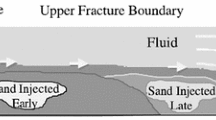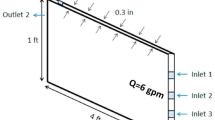Abstract
A new numerical model for hydraulic fracturing has been developed. This model takes into account several simultaneous processes: pumping of proppant-laden slurry and its flow through the fracture, fracture growth with variable height and length, proppant settling, forming of proppant packing, and fluid filtration through this packing. Simulation experiments demonstrated that proppant particle diameter has significant influence on forming the proppant packing, fluid filtration through the packing, and, finally, on the fracture length and ultimate distribution of fracture width.
Similar content being viewed by others
References
S.A. Boronin and A.A. Osiptsov, Two-continua model of suspension flow in a hydraulic fracture, Doklady Phys-ics, 2010, Vol. 55, No. 4, P. 199–202.
S.A. Boronin and A.A. Osiptsov, Effects of particle migration on suspension flow in a hydraulic fracture, Fluid Mechanics, 2014, Vol. 49, No.2, P. 208–221.
E.V. Dontsov and A.P. Peirce, Slurry flow, gravitational settling and a proppant transport model for hydraulic fractures, J. Fluid Mech., 2014, Vol. 760, P. 567–590.
B. Lecampion and D.I. Garagash, Confined flow of suspensions modelled by a frictional rheology, J. Fluid Mech., 2014, Vol. 759, P. 197–235.
A.A. Osiptsov, Fluid mechanics of hydraulic fracturing: a review, J. Petroleum Science and Engng, 2017, Vol. 156, P. 513–535.
T.K. Perkins and L.R. Kern, Widths of hydraulic fractures, J. Petroleum Technology, 1961, Vol. 13, No. 9, P. 937–949.
R.P. Nordgren, Propagation of a vertical hydraulic fracture, SPE J., 1972, Vol. 12, No. 4, P. 306–314.
P.S. Hammond, Settling and slumping in a newtonian slurry, and implications for proppant placement during hydraulic fracturing of gas wells, Chemical Engng Sci., 1995, Vol. 50, No. 20, P. 3247–3260.
A.T. Mobbs and P.S. Hammond, Computer simulations of proppant transport in a hydraulic fracture, SPE Production & Facilities, 2001, Vol. 16, No. 2, P. 112–121.
R.D. Barree and M.W. Conway, Proppant holdup, bridging, and screenout behavior in naturally fractured reser-voirs, SPE Production and Operations Symposium. Soc. Petroleum Engineers, 2001, No. SPE-67298-MS, P. 1–7.
J. Adachi, E. Siebrits, A. Peirce, and J. Desroches, Computer simulation of hydraulic fractures, Int. J. Rock Mech. and Mining Sci., 2007, Vol. 44, No. 5, P. 739–757.
A. Lakhtychkin, D. Eskin, and O. Vinogradov, Modelling of transport of two proppant laden immiscible power-law fluids through an expanding fracture, Canadian J. Chemical Engng, 2012, Vol. 90, No. 3, P. 528–543.
P.B. Gadde and M.M. Sharma, The impact of proppant retardation on propped fracture lengths, in: 2005 SPE Annual Technical Conference and Exhibition, USA, Dallas, Texas, 2005, P. 9–12.
S. Shiozawa and M. McClure, Simulation of proppant transport with gravitational settling and fracture closure in a three-dimensional hydraulic fracturing simulator, J. Petroleum Sci. and Engng, 2016, Vol. 138, P. 298–314.
E.V. Dontsov and A.P. Peirce, Proppant transport in hydraulic fracturing: Crack tip screen-out in KGD and P3D models, Int. J. Solids and Structures, 2015, Vol. 63, P. 206–218.
F. Boyer, E. Guazzelli, and O. Pouliquen, Unifying suspension and granular rheology, Phys. Rev. Letters, 2011, Vol. 107, No. 18, P. 188301–1–188301–5.
G.R. Coulter and R.D. Wells, The advantages of high proppant concentration in fracture stimulation, J. Petroleum Technology, 1972, Vol. 24, No. 06, P. 643–650.
Yu. Shokin, S. Cherny, D. Esipov, V. Lapin, A. Lyutov, and D. Kuranakov, Three-dimensional model of fracture propagation from the cavity caused by quasistatic load or viscous fluid pumping, Commun. in Computer and Information Sci., 2015, Vol. 549, P. 143–157.
S. Cherny, V. Lapin, D. Esipov, D. Kuranakov, A. Avdyushenko, A. Lyutov, and P. Karnakov, Simulating fully 3D non-planar evolution of hydraulic fractures, Int. J. Fracture, 2016, Vol. 201, No. 2, P. 181–211.
S.G. Cherny, V.N. Lapin, D.V. Esipov, and D.S. Kuranakov, Methods for Simulation of Fracture Initiation and Growth, SB RAS Publ., Novosibirsk, 2016.
E. Detournay, Mechanics of hydraulic fractures, Annual Review of Fluid Mechanics, 2016, Vol. 48, No. 1, P. 311–339.
R.D. Carter, Derivation of the general equation for estimating the extent of the fractured area. Appendix I of drilling and production practice, G.C. Howard and C.R. Fast (Eds.), N.Y.: American Petroleum Institute, 1957, P. 261–270.
I.N. Sneddon, The distribution of stress in the neighborhood of a crack in an elastic solid, in: Proc. Roy. Soc. A: Math., Phys., and Engng Sci., 1946, Vol. 187, No. 1009, P. 229–260.
B.R. Meyer, L.W. Bazan, and D. Walls, Modeling of proppant permeability and inertial factor for fluid flow through packed columns, in: ISRM Int. Conf. for Effective and Sustainable Hydraulic Fracturing, Int. Society for Rock Mechanics, 2013, P. 549–569.
S.H. Maron and P.E. Pierce, Application of Ree-Eyring generalized flow theory to suspensions of spherical particles, J. Colloid Sci., 1956, Vol. 11, No. 1, P. 80–95.
S. Mueller, E.W. Llewellin, and H.M. Mader, The rheology of suspensions of solid particles, The Roy. Soc., 2009, Vol. 466, P. 1201–1228.
P.V. Karnakov, V.N. Lapin, and S.G. Cherny, Model of formation fracturing including the mechanism of proppant bridging, Vestnik NGU, series: Information Technology, 2014, Vol. 12, No. 1, P. 19–33.
J.P. Van Doormaal and G.D. Raithby, Enhancements of the simple method for predicting incompressible fluid flows, Numerical Heat Transfer. 1984. Vol. 7, No. 2. P. 147–163.
F.H. Harlow and M.W. Evans, A machine calculation method for hydrodynamic problems, Los Alamos Scientific Laboratory report LAMS-1956.
M.J. Economides and K.G. Nolte, Reservoir Stimulation. Third edition. John Wiley & Sons, 2000.
Author information
Authors and Affiliations
Corresponding author
Additional information
Research was supported by the Russian Science Foundation grant (Project No. 17-71-20139).
Rights and permissions
About this article
Cite this article
Karnakov, P.V., Kuranakov, D.S., Lapin, V.N. et al. Peculiarities of the hydraulic fracture propagation caused by pumping of proppant-fluid slurry. Thermophys. Aeromech. 25, 587–603 (2018). https://doi.org/10.1134/S086986431804011X
Received:
Revised:
Published:
Issue Date:
DOI: https://doi.org/10.1134/S086986431804011X




